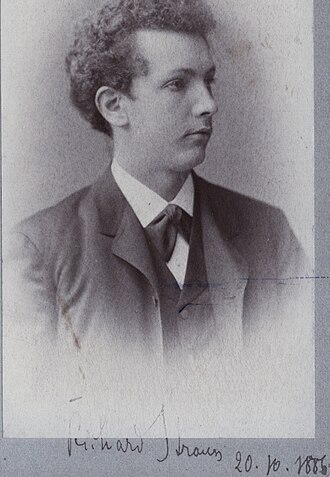Richard Strauss
Strauss, along with Gustav Mahler, represents the late flowering of German Romanticism after Richard Wagner, in which pioneering subtleties of orchestration are combined with an advanced harmonic style.
[바그너 이 후 가장 뛰어난 독일의 작곡가로 불리는 리하르트 슈트라우스가 23세때인 1917년에 작곡된 그의 유일한 바이올린 소나타이다. 바이올린의 대가였던 부르흐에게 작곡을 사사, 부르흐의 낭만적 서정과 색체를 느낄수 있으며, 그의 초기작품으로 현대음악적인 스케일이나 화성보다는 청년 시절의 풋풋한 시적인 서정으로 가득한 작품으로 그가 남긴 명곡들중의 하나로 꼽히는 작품이다.]
The Violin Sonata in E-flat, Op. 18 was written by Richard Strauss between 1887-1888. Although not considered a milestone in violin literature, it is frequently performed and recorded. It is often noted for its lyrical beauty and its technical demands made on both violinist and pianist
History
Following the completion of his Cello Sonata and Piano Sonata, Strauss began working on his Violin Sonata in 1887, and finished it in 1888. It was during this time that Strauss fell in love with Pauline de Ahna, the soprano whom he would later wed, and his amorous feelings can be heard throughout the piece.[2]
Structure
Like all of his chamber music, Strauss' sonata follows standard classical form, though it is considered the last of his works to do so.[3] The piece is in three movements, and takes approximately thirty minutes to perform:
- Allegro, ma non troppo
- Improvisation: Andante cantabile
- Finale: Andante - Allegro
The first movement opens with a brief piano solo, followed by lyrical violin interludes, through which the thematic material is presented. This movement follows typical sonata-allegro form, and although it begins in a melancholy tone, the movement ends jubilantly.
The second movement is unique in that it is an Improvisation; that is, the tranquil violin passages give the impression of improvisational material. This movement maintains a beautiful singing tone throughout, and ends meditatively.
The third and final movement begins with a slow, methodical piano introduction which then leads into an exuberant Allegro. After a rush of virtuosic passages from both performers, the sonata comes to an explosive end.
'♣ 음악 감상실 ♣ > - Sonata' 카테고리의 다른 글
| Luise Adolpha Le Beau- "Sonate" für Klavier und Violoncello op. 17 (0) | 2016.06.25 |
|---|---|
| Eduard Franck - Violin Sonata No. 2 in A Major, Op. 23 (0) | 2016.06.19 |
| Respighi - Violin Sonata in B minor P 110 (0) | 2016.05.08 |
| F-A-E Sonata (0) | 2016.04.29 |
| Chopin - Cello Sonata in G minor (0) | 2016.04.29 |

